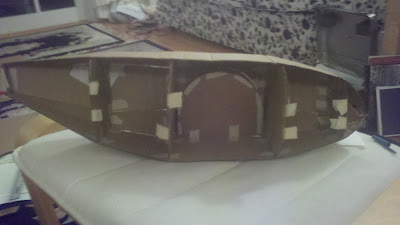1st weekend of oktober, at Breehees, Goirle, a gathering of recumbent riders was organized. Being this very, very near to my house, I just had to go there with the PlyMobile. I expected lots of talk and discussions about the bike. I was just right. Several people had to go to the local supermarket, so I guided them, leading them with the plymobile.

I deliberately fixed the front supension and went full throttle, purely to test the strenth of the glass fibre reinforcements. I heard cracking like noises along the way, but couldn't find a single crack afterwards. test succesful, strong body I'd say. I don't know if the wheel covers work well, at least they look good. In this picture I show the chain tunnel onder the bottom: made from plastic bags. Theat's really cheap and ultra low weight. But it easily adds friction because of the chain hanging into these bags. The idea is good anyway.

The time this picture was made, most velonauts were chatting with each other inside, but still some people wanted to see the bike. Another day, someone else did take a ride with the bike and I followed with a quest. The bike, being 10 kg lighter than a quest, took off much quicker and I had to catch up with the heavier quest. The difference was clearly noticeable. That bike was fitted with a speedometer: the PlyMobile does 36 km/h, faster than a regular bike, but way slower than a quest.
Now the bike works good and reliable, it's time for me to start my own wooden builds. Anyone interested to further develop this PlyMobile? You can contact me (Joost Evers, you can see me in the pictures lately) for questions at
fietswiel@home.nl or the person that is the owner of this blog, Titus van den Brink.
































